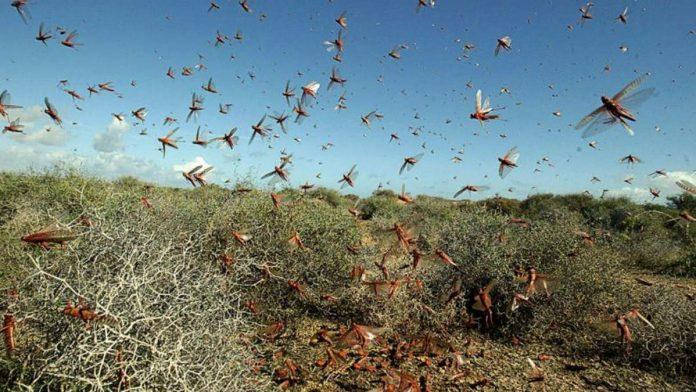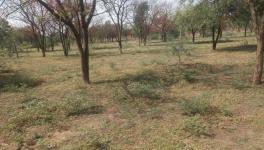Locust Infestation Crisis: Climate Change May Be a Factor

Image for representational use only.Image Courtesy : The Print
The threat, courtesy a serious locust infestation that reached India in July last year, continues to remain, with experts pointing in the direction of climate change as a cause for exacerbation.
Since the first wave of the desert locust hit Rajasthan in May 2019, the pest, which was not expected to last post-October and the monsoon, has stayed behind. In January, a report in The Times of India mentioned that crop spread over 3.6 lakh hectares in Rajasthan had been affected across 10 districts in the state. On January 24, Bihari Lal, BJP MLA from Nokha in Bikaner, entered the Assembly with a bucket full of locusts to make a point, asking for compensation to be paid to the farmers whose crops had been attacked.
On February 7, Minister of Agriculture and Farmers’ Welfare, Narendra Singh Tomar informed Rajya Sabha that the affected crop area in Gujarat and Rajasthan stood at 18,727 hectares and 1,49,821 hectares respectively. Both the state governments have announced compensation for the affected farmers, the Gujarat government giving a relief package of “Rs. 32.76 crore for approximate 11,230 farmers” and Rajasthan paying Rs 86.21 crore to 54,150 farmers.
The desert locust (Schistocerca gregaria), weighs close to two grams, and is considered the “most dangerous migratory pest”, according to Keith Cressman, a senior locust forecasting officer with the Food and Agriculture Organisation of the United Nations. Locust swarms look like a cloud descending, and they can fly up to 150 kilometre a day, consuming their body-weight in food during the day. They can multiply between 16 and 20 times in three months in optimal conditions.
In July last year, Tomar had responded to a question in Lok Sabha and informed the House that India and Pakistan were cooperating to control the outbreak of locusts which entered the Thar desert from the neighbourhood. However, what Tomar also told the lower House was that the “breeding season of locusts spans from June/July to October/November every year”. Locusts generally thrive when rains are aplenty; increasing vegetation cover also aids their breeding.
On February 4, the TOI reported that a fresh swarm of locusts, about 3 kilometre in width and a
kilometre in length entered Punjab via Fazilka district on the Indo-Pak border. After a reported 13-hour skirmish, between 400-500 tonnes of pesticides were used to control the influx.
The last time India faced a serious locust attack was in 1993, and experts have pointed out the difference. “Back then, locusts stayed for two months and affected the kharif crop. This time around, however, they stayed for over six months and affected the rabi crop. In the long term, it does seem to be a case of the climate changing,” Dr. Pradeep Pagaria, scientist and head of the Krishi Vigyan Kendra in Barmer, Rajasthan, told NewsClick. Pagaria says that conditions favourable for locust breeding continued to persist, “so, they continued to grow and move,” even between the months of November and January.
In a recent interview to Down To Earth magazine, Keith Cressman also elaborated on the impact that climate change could have had. Cressman is quoted as saying that it was the first time since the 1950s that locusts had stayed on after October/November, mentioning that they stayed back this year due to a good monsoon.
“In 2019, monsoon started six weeks before time (first week of July) in Western India, especially in locust-infested areas. It also lasted a month longer — till November, instead of the usual September/October. Extended rains created excellent breeding conditions for the locust, while also producing natural vegetation on which they could feed longer,” he reportedly said.
Cressman also elaborated on the fact that “wind patterns” have been changing over India and Pakistan and that there are more cyclones in the region owing to the climate change. “Cyclones bring rain to coastal Gujarat, Pakistan, Arabian Peninsula, Somalia and Northeastern Africa. This creates good breeding conditions. History shows that these plagues spread due to cyclonic winds,” he said.
Pagaria said that locust-breeding generally stops when it turns cold during winters, hinting at either climatic changes or resistance by the pests themselves. “This time around, they got favourable temperatures and kept breeding, even in the cold. We hoped that they wouldn’t, but it seems that they found the conditions favourable somehow; maybe even developed resistance for it. So, they stayed on for four months,” he added.
According to him, 38,000 hectares of area has been affected in Barmer out of 3 lakh hectares in all in the districts, which grows cash crops like cumin seeds and isabgol (Psyllium).
Pagaria further mentioned that temperatures in Barmer generally range between 40 degree Celsius and 50 degree Celsius in summer and it’s difficult for breeding to continue. “After March, crops will also be cut and farmers generally don’t sow during April-May. So, locusts have lesser areas to attack. If the rains come early, then June-August may be tough though,” he said, mentioning that rains even in the next five to six days “could pose a problem”.
Also read: Stop Building Divisive Agenda on Climate Migration, Says CSE Report
Get the latest reports & analysis with people's perspective on Protests, movements & deep analytical videos, discussions of the current affairs in your Telegram app. Subscribe to NewsClick's Telegram channel & get Real-Time updates on stories, as they get published on our website.
























